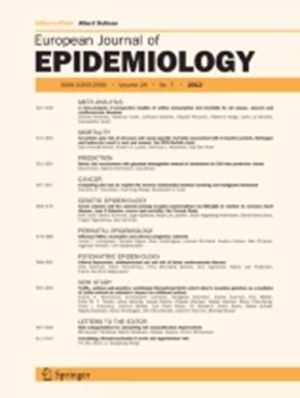Associations between multiple perinatal exposures and risk of childhood hospitalisation with infection: a registry-based study in two countries.
IF 5.9
1区 医学
Q1 PUBLIC, ENVIRONMENTAL & OCCUPATIONAL HEALTH
引用次数: 0
Abstract
Several perinatal exposures impact severe infection risk in offspring. However, most studies consider exposures in isolation rather than the impact of multiple co-occurring perinatal exposures. Here, we investigated the risk of hospitalised childhood infections associated with combinations of multiple perinatal exposures. We studied liveborn, singleton births in Denmark between 1997 and 2019 (n = 1,113,708) and Norway between 2008 and 2018 (n = 470,270) through national registry linkage. Seven perinatal exposures were evaluated including maternal antibiotic use during pregnancy, maternal smoking, maternal diabetes, hypertensive disorders of pregnancy, caesarean section birth, offspring being small for gestational age (SGA), and preterm birth. The outcome was hospitalised infections before 5 years age. Using Cox regression, we estimated hazard ratios (HR) of hospitalised infections for: (1) each exposure individually; (2) the cumulative number of exposures; (3) each unique combination of the seven exposures; (4) pairwise interactions between exposures. Results were combined through meta-analysis. Each exposure was individually associated with greater hospitalised infection risk with pooled HR estimates ranging from 1.08 (95% CI 1.08-1.09) for SGA to 1.45 (95% CI 1.43-1.46) for preterm birth. Cumulative risk was observed for increasing number of exposures from a pooled HR of 1.17 (95% CI 1.17-1.18) for one exposure to 1.88 (95% CI 1.78-1.99) for five or more exposures. Analyses of unique combinations of the exposures showed a particularly increased risk among preterm children with one or more additional exposures. Our findings can inform targeted strategies for the prevention and management of childhood infections. We highlight a simple, intuitive method for measuring risk associated with co-occurring exposures.多次围产期暴露与儿童感染住院风险之间的关系:两个国家的基于登记的研究
几种围产期暴露会影响后代的严重感染风险。然而,大多数研究考虑的是孤立的暴露,而不是多重同时发生的围产期暴露的影响。在这里,我们调查了住院儿童感染的风险与多个围产期暴露的组合。我们通过国家登记联系研究了1997年至2019年丹麦(n = 1,113,708)和2008年至2018年挪威(n = 470,270)的活产单胎婴儿。研究评估了7种围产期暴露,包括孕妇在妊娠期间使用抗生素、孕妇吸烟、孕妇糖尿病、妊娠高血压疾病、剖宫产、胎儿小于胎龄(SGA)和早产。结果是5岁前住院感染。使用Cox回归,我们估计了住院感染的风险比(HR):(1)每个暴露单独;(二)累计暴露次数;(3)七个曝光的每个独特组合;(4)暴露之间的两两相互作用。结果通过meta分析合并。每次暴露单独与住院感染风险增加相关,合并HR估计范围从SGA的1.08 (95% CI 1.08-1.09)到早产的1.45 (95% CI 1.43-1.46)。累积风险随着暴露次数的增加而增加,从一次暴露的总危险度为1.17 (95% CI 1.17-1.18)到五次或更多暴露的总危险度为1.88 (95% CI 1.78-1.99)。对暴露的独特组合进行的分析表明,有一种或多种额外暴露的早产儿的风险尤其增加。我们的发现可以为儿童感染的预防和管理提供有针对性的策略。我们强调了一种简单、直观的方法来测量与同时发生的暴露相关的风险。
本文章由计算机程序翻译,如有差异,请以英文原文为准。
求助全文
约1分钟内获得全文
求助全文
来源期刊

European Journal of Epidemiology
医学-公共卫生、环境卫生与职业卫生
CiteScore
21.40
自引率
1.50%
发文量
109
审稿时长
6-12 weeks
期刊介绍:
The European Journal of Epidemiology, established in 1985, is a peer-reviewed publication that provides a platform for discussions on epidemiology in its broadest sense. It covers various aspects of epidemiologic research and statistical methods. The journal facilitates communication between researchers, educators, and practitioners in epidemiology, including those in clinical and community medicine. Contributions from diverse fields such as public health, preventive medicine, clinical medicine, health economics, and computational biology and data science, in relation to health and disease, are encouraged. While accepting submissions from all over the world, the journal particularly emphasizes European topics relevant to epidemiology. The published articles consist of empirical research findings, developments in methodology, and opinion pieces.
 求助内容:
求助内容: 应助结果提醒方式:
应助结果提醒方式:


